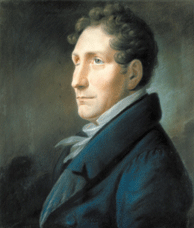Friedrich Kuhlau facts for kids
Friedrich Daniel Rudolf Kuhlau (born in Germany, sometimes called Frederick Kulav in Danish) was a Danish pianist and composer. He lived from 1786 to 1832. His music connects the late Classical and early Romantic times. He was a very important person during the Danish Golden Age. He is especially remembered for his music for Elves' Hill. This play was a big step for Danish National Romanticism and secretly honored the king. Even today, his music for this play is the most famous version.
During his life, Kuhlau was known as a concert pianist and a composer of Danish operas. He also introduced many of Beethoven's works to audiences in Copenhagen. Kuhlau wrote a lot of music. Even though his house burned down and destroyed many of his unreleased works, he still had over 200 published pieces in many different styles.
Contents
Early Life and Learning
Kuhlau was born on September 11, 1786, in Germany. When he was seven, he had an accident. He slipped on ice and lost his right eye. His father, grandfather, and uncle were all military oboists, who play a type of wind instrument. Even though his family was not rich, his parents made sure he could take piano lessons. In 1802, he moved to Hamburg and started learning the piano more seriously.
Kuhlau's Music Career
In 1804, Kuhlau performed for the first time as a concert pianist. Around this time, he started writing songs and chamber music (music for small groups of instruments) to earn money. He wrote many pieces for the flute, even though he didn't play it himself! In 1810, he moved to Copenhagen to avoid being forced to join the army during the Napoleonic Wars. That same year, he published his first piano and flute music.
Kuhlau made a living in Copenhagen by teaching piano and composing. In 1812, he became a musician for the Danish Court, though he wasn't paid a regular salary at first. He became a Danish citizen in 1813. After his play The Robber's Castle became a success, Kuhlau got a good job teaching singing at the Royal Theater in 1816.
Some of his works between 1817 and 1820 were not very popular. His opera, The Magic Harp, was said to have failed because its story was controversial. In 1821 and 1825, Kuhlau traveled to Vienna. There, he became friends with Ludwig van Beethoven, another famous composer. Beethoven's influence can be seen in Kuhlau's later works. This includes his play, Elves' Hill. This work is seen as a tribute to the Danish Monarchy and an inspiring piece from the Danish Golden Age. In 1828, Kuhlau was given an honorary professorship, which is a special title for a professor.
Kuhlau's Musical Works
Operas and Plays
Kuhlau became very famous in 1814 at the Royal Danish Theatre. This was with his play Røverborgen (which means "The Robbers' Castle"). It was a singspiel, a type of play with singing and spoken dialogue. The story was written by Adam Oehlenschläger.
His next few plays, like Trylleharpen (1817), Elisa (1820), and Hugo og Adelheid (1827), were not very dramatic and did not do well. But in 1824, he had another success with his singspiel Lulu. He also wrote music for performances of William Shakespeare's plays.
In 1828, Kuhlau had his biggest success with the music for Elverhøj (Elves' Hill). It became popular right away. People especially loved its overture (the music played at the beginning) and the final royal song. This song was his version of "Kong Christian stod ved høien Mast" (King Christian Stood by the Towering Mast). In this music, Kuhlau used Danish and Swedish folk tunes very well. In 1976, the overture was used in a famous scene in the Danish film The Olsen Gang Sees Red. The scene shows the Olsen Gang breaking into The Royal Theater. Their actions are perfectly timed to Kuhlau's music. This scene is one of the most famous in Danish film history.
Other Compositions
Besides his plays, Kuhlau wrote many pieces for the flute. He also wrote a lot of music for the piano. His short pieces for piano, called sonatinas, were very popular in Denmark and other countries.
Beethoven, whom Kuhlau knew personally, had a big influence on his music. Kuhlau's Piano Concerto in C major, written in 1810, sounds a lot like Beethoven's Piano Concerto No. 1 in C major. This shows how Kuhlau was inspired by Beethoven.
Kuhlau also wrote a string quartet and many other piano pieces. These included all the popular types of music at the time: sonatas, sonatinas, waltzes, rondos (a type of musical form), and variations (where a melody is changed in different ways). He also created pieces for strings with piano, like three quartets and two quintets, and several violin sonatas. He wrote music for plays and several operas. However, his most often played and recorded works are his piano sonatinas and his many pieces for the flute. Because of his flute works, he was even called "the Beethoven of the flute" during his lifetime.
See also
 In Spanish: Friedrich Kuhlau para niños
In Spanish: Friedrich Kuhlau para niños


